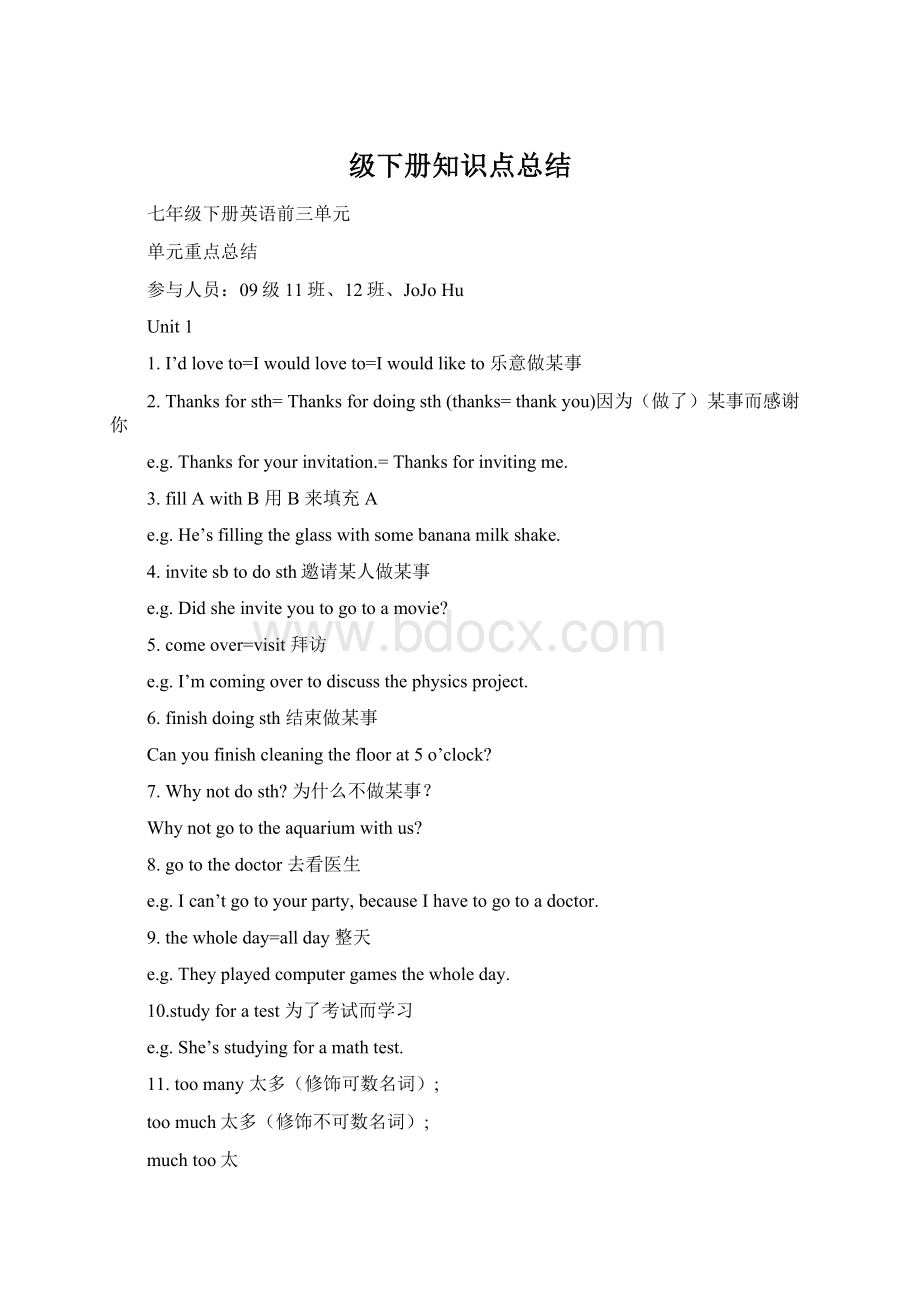级下册知识点总结.docx
《级下册知识点总结.docx》由会员分享,可在线阅读,更多相关《级下册知识点总结.docx(13页珍藏版)》请在冰豆网上搜索。

级下册知识点总结
七年级下册英语前三单元
单元重点总结
参与人员:
09级11班、12班、JoJoHu
Unit1
1.I’dloveto=Iwouldloveto=Iwouldliketo乐意做某事
2.Thanksforsth=Thanksfordoingsth(thanks=thankyou)因为(做了)某事而感谢你
e.g.Thanksforyourinvitation.=Thanksforinvitingme.
3.fillAwithB用B来填充A
e.g.He’sfillingtheglasswithsomebananamilkshake.
4.invitesbtodosth邀请某人做某事
e.g.Didsheinviteyoutogotoamovie?
5.comeover=visit拜访
e.g.I’mcomingovertodiscussthephysicsproject.
6.finishdoingsth结束做某事
Canyoufinishcleaningthefloorat5o’clock?
7.Whynotdosth?
为什么不做某事?
Whynotgototheaquariumwithus?
8.gotothedoctor去看医生
e.g.Ican’tgotoyourparty,becauseIhavetogotoadoctor.
9.thewholeday=allday整天
e.g.Theyplayedcomputergamesthewholeday.
10.studyforatest为了考试而学习
e.g.She’sstudyingforamathtest.
11.toomany太多(修饰可数名词);
toomuch太多(修饰不可数名词);
muchtoo太
e.g.Therearetoomanystudentsinaclassroom.
e.g.Wehavetoomuchhomeworktodo.
e.g.I’mmuchtoohappy.
12.babysit---babysitting照顾(婴儿)
13.maybeanothertime或许其他时间(或许下一次)
14.What’sthedatetoday?
今天几号?
Whatdayisittoday?
今天星期几?
What’stoday?
今天几号,是星期几?
15.现在进行时表示计划将来要做的事情
Unit2
变化规则
例子
变化规则
例子
一般情况直接在词尾加--er
tall—taller
以“辅音字母加y”结尾的词,先变y为i再加--er
funny—funnier
以—e结尾的词,直接在词尾,加--r
cute—cuter
大多数多音节的词由more来构成比较级
beautiful——
morebeautiful
以重读闭音节结尾,且词尾只有一个辅音
字母的词,先双写尾字母,再加--er
big—bigger
2.Ais形容词的比较级thanB
3.thankyouforsth=thankyoufordoingsth
4.last上一个
5.twinsister双胞胎姐妹
6.Hereare这里是
7.as正如asyoucansee正如你看到的那样
8.insomeways在某些方面inotherways在其他方面inmanyways在许多方面
9.lookthesame看起来一样
10.lookdifferent看起来不同
11.both两者都both用于实义动词之前,be动词之后
12.although=though尽管不能与but连用
13.hers名词性物主代词=形容词性物主代词+名词
14.However然而,表示转折
15.enjoydoingsth享受做某事
16.soon尽快
17.morethan=over超出LiuLihasmorethanonesister.
18.incommon共同点havesthincommon
19.begoodat擅长begoodatdoingsth擅长做某事
beasgoodatsth/assb.像某人一样擅长
benotasgoodsthassb.像某人一样不擅长
as形容词as人像某人一样怎么样
20.both两者都(用于名词前)
21.alittle/much/alot/abit/far/even都修饰形容词的比较级
22.Iamquieterthanmostofthekidsinmyclass.我比我们班大部分孩子都安静。
23.Therearesomedifferences,though.即使我们也有一些不同。
24.It’snotnecessarytobethesame.没有必要完全相同。
25.Ilikefriendswhoarelikeme.我喜欢像我一样的朋友。
26.Ilikefriendswhoaredifferentfromme.我喜欢和我不同的人交朋友。
27.Healwaysbeatsmeintennis.他经常在网球方面打败我。
28.Idon’treallycare.我真的不在乎。
29.laughat嘲笑
30.It’s+形容词+forsb+todosth
31.haveaninterestin=beinterestedin
Unit3
词组:
1.drinkthemilkshake喝奶昔
2.pourthemilkintotheblender把牛奶倒入搅拌器
3.peelthreebananas剥三个香蕉
4.cutupthebananas把香蕉切碎
5.turnontheblender打开搅拌机
6.putthebananasandicecreamintheblender把香蕉和冰激凌倒入搅拌机
7.onecupofyogurt/twoteaspoonsofhoney/abowloficecream
数词+量词+of+不可数名词(数词大于一时,量词要加“s”)
8.pour……into将…(液体)倒入…
put……into将…(固体)放入…
add……to将…加入…
cutup切碎
turnon打开
turnoff关闭
turnup调大音量
turndown调小音量
mixup混合在一起
9.动词+介词+名词=动词+代词+介词
Turnontheblender=Turniton
10.名词性物主代词=形容词性物主代词+名词
人称代词
物主代词
主格
宾格
形容词性物主代词
名词性物主代词
第一人称单数
I
me
my
mine
第二人称单数
you
you
your
yours
第三人称单数
he
him
his
his
第三人称单数
she
her
her
hers
第三人称单数
it
it
its
its
第一人称复数
we
us
our
ours
第二人称复数
you
you
your
yours
第三人称复数
they
them
their
theirs
11.first……next……then……finally
12.many=alargenumberof+可数名词复数
much=alargeamountof+不可数名词
alotof即可修饰可数名词,也可修饰不可数名词。
13.boilthenoodles煮面条
14.turkey/beef/chickensandwich火鸡、牛肉、鸡肉三明治
15.rollthepancake卷起煎饼
16.feellikedoingsth想做某事
17.ontime按时
18.bebrokendown坏掉
19.needtodosth需要做某事
20.可数名词的复数形式表示一类物品
21.alittle修饰不可数名词afew修饰可数名词的复数形式
22.smoothie=milkshake
句子:
1.Howdoyoumakea……?
你怎么做…?
2.Howmany(可数名词复数)……doweneed?
我们需要多少…?
Howmuch(不可数名词)……doweneed?
我们需要多少…?
3.DoyoulikeAinB?
你喜欢B里面放A吗?
Doyoulikelettuceinsandwiches?
DoyoulikeAwithB?
你喜欢带有B的A吗?
Doyoulikesandwicheswithlettuce?
4.Hereisarecipefor……!
这里是做…的食谱。
5.Turnontheblenderforabouttwominutes.打开搅拌器持续两分钟。
(将搅拌机打开两分钟)
Unit4—Unit6知识总结
Unit4:
1.therebe句型过去式:
therewastherewere
2.haveagoodtime=havefun=enjoyoneself
3.atthebeginningof…在……开始时
attheendof…在……快结束时
4.Wakeup醒来gocamping去露营sleeplate起得晚
putsthout把……东西拿出去getwet变湿
infuture在将来
5.late,early是副词
Unit5:
1.befamousfor以……而著名
befamousas作为……而著名
2.too…to太……以至于不能……(可以与so…that“如此……以至于”和enoughto“足够……可以做”互换
3.called,named,被叫做
4.playasport=playsports=doexercises
5.时间+ago表示……之前
6.spend+sometime+doingsth
spend+sometime+onsth
spend+sometime+withsb
7.takepartin+事件,joinin+组织
8.fristprize一等奖(很多)thefristprize第一名(一位)
9.sbbethefristtodosth某人第一个做某事
sbbethelasttodosth某人最后一个做某事
10.because+句子,becauseof+名词或词组
11.when=attheageof
12.startdoingsth=starttodosth
13.golfn.高尔夫球v.打高尔夫球
14.atthesametime同时
15.learnfromsb向某人学习learntodosth学习做某事
16.allhisfreetime他所有的空闲时间
Unit6:
1.带双宾语的动词
showsbsth=showsthtosbsendsbsth=sendsthtosb
getsbsth=getsthforsbbuysbsth=buysthforsb
givesbsth=givesthtosbtellsbsth=tellsthtosb
takesbsth=takesthtosbbringsbsth=bringsthtosb
2.表示计划做某事的方式
bedoingsth,begoingtodosth,plantodosth,thinkaboutdoingsth
3.decidetodosth
decideonsth
decideondoingsth
4.动词加ed构成的形容词,翻译成“……的”,修饰人;动词加ing构成的形容词,翻译成“令人……的”,修饰物。
5.
takea+
wake
trip
vacation
class
shower
rest
break
photo
6.gohiking去远足gosightseeing去观光
gofishing去钓鱼gobikeriding去骑单车
7.leave是动词,away是副词(通常与动词构成词组)
8.lives{life【n.】变复数:
lives
{live【v.】三单形式:
lives
9.intheopenair在户外
can’twaittodosth迫不及待做某事
placeofinterest名胜(复数)placesofinterest
10.returnto+出发地,意为“返回某地”;returnfrom+目的地,意为“从……地方回来”。
U7知识总结
1.begoingtodo=will一般将来时
2.ayearortwo=oneortwoyears一两年
adayortwo=oneortwodays一两天
3.allover到处allovertheworld=aroundtheworld全世界
travelallovertheworld环游世界
4.getgoodgrades取得好成绩takeactinglessons上表演课getlotsofexercise做大量的运动savesomemoney存一些钱holdartexhibitions举办艺术展
5.somewhere,anywhere,nowhere后面加形容词
6.keepfit=keephealthy=keepingoodhealth=stayhealthy保持健康
keep+adj.保持某种状态
7.over=morethan多于
8.get…from…从……处得到……
9.touraround旅游
municatewithsb与某人沟通
11.movetosp搬到某地
movetoAfromB从B处搬到A处
12.growup长大
13.表目的:
to+动词原型;for+名词
14.yet一般用于疑问句或否定句中,表示“至今”,常用在句末。
1.U8
2.could,情态动词,用于委婉地向别人提出请求
Q:
Couldyou…?
A:
Yes,Ican/No,Ican’t.
用于委婉请求别人允许自己做某事
Q:
CouldI…?
A:
Yes,youcan/No,youcan’t.
2.dodhedishes洗餐具sweepthefloor扫地
takeoutthetrash倒垃圾makeyourbed整理你的床铺
foldyourclothes叠衣服cleanthelivingroom打扫客厅
stayoutlate在外面呆的很晚usethecar使用汽车
dochores做家务dothelaundry洗衣服
cookameal做一顿饭getaride搭车
buysomesnacks买一些小吃
3.downtown市中心uptown郊区
4.lend和borrow的区别
A借给B某物
AlendBsth
AlendsthtoB
BborrowsthfromA
5.讨厌做某事
hatetodosth=hatedoingsth
与liketodosth=likedoingsth为反义词组
6.becarefulwith…对……小心
7.feed
把A喂给B
feedAtoB
feedBwithA
8.takecareof=lookafter照顾
9.thanksto多亏了thanksfor为……而感谢
10.falldown掉下来
11.lookfor寻找lookafter照顾lookat看lookover检查
条件
变成比较级
变成高级
一般情况
直接加er
直接加est
以e结尾
直接加r
直接加st
以辅音字母加y
变y为i加er
变y为i加est
重读闭音节且词尾只有一个辅音字母
双写尾字母加er
双写尾字母加est
多音节词
单词前加more
单词前加most
2.thinkof=thinkabout=likeabout
3.make/doasurveyof…对……做调查
介词of后面多接名词或代词。
4.overtheradio在广播上onTV在电视上
5.表示某人获了某奖项的表达方式:
(1)…isthe…
(2)…wintheprizefor…
(3)theprizefor…goto…
6.dancewithoutmusic没有音乐伴奏跳舞
without无,没有,反义词是with,它们都是介词.
7.act[v.]表演=perform
[n.]演员=performer
8.asksbaboutsth询问某人关于某事的信息
asksbsomequestionsaboutsth询问某人一些关于某事的问题
UNIT10
1.反意疑问句结构:
(1)由两部分组成,前半句是陈述句,后半句是疑问句。
(2)如果前半句是肯定句,后半句则是否定句;如果前半句是否定句,后半句则是肯定句。
(3)除therebe句型外,反意疑问句疑问部分必须与陈述部分在人称,数,时态上保持一致。
2.must作情态动词时,肯定形式是must,否定形式是needn’t,而mustn’t意为“禁止”。
3.waitinline排队等候inanelevator在电梯里,乘电梯
4.waittodosth等待做某事
can’twaittodosth迫不及待做某事
can’thelpdoingsth情不自禁做某事
5.sthcost(costs)sb+money
sbspend+money+onsth
6.Whatisthepriceofthatshirt?
=Howmuchisthatshirt?
=Howmuchdidthatshirtcost?
7.price价格是一个数字,高:
high低:
low
something某物,贵:
expensive便宜:
cheap
8.cross[v.]穿过
across介词,从……的表面穿过;through介词,从……的里面穿过
条件
比较级
例子
最高级
例子
一般情况
直接加er
taller
直接加est
tallest
以不发音的e结尾
直接加r
nicer
直接加st
nicest
以一个辅音字母结尾的重读闭音节的单词
双写尾字母加er
bigger
双写尾字母加est
biggest
以辅音字母加y结尾的词
变y为i再加er
heavier
变y为i再加est
heaviest
多音节词
单词前+more
moreinteresting
单词前+est
most
interesting
best
2.不规则的单词:
good
well
bad
badly
littlelessleast
many
much
far
3.
(1)表示A与B在程度上相同时,“as+形容词或副词的原级+as”结构。
表示A不如B时,可用“notas/so+形容词或副词的原级+as”结构。
(2)表示A比B在程度上“更…..”时,可用“形容词或副词的比较级+than”结构;表示三者或三者以上的比较,其中一个在程度上“最…..”时,常用“the+形容词或副词的最高级”结构,后面可带of/in的短语来说明比较的范围。
(副词的最高级在句中常省略“the”.)
(3)修饰形容词或副词的比较级的词,可以用“alittle,even,far,much,still,alot,some,yet,abit”的等词语来修饰。
(4)in/after。
in是指以现在时间为起点的“在一段时间以后”。
也可以表示“在将来多少时间之内”,句子中的谓语动词要用一般将来时态;after常指以过去时间为起点的“一段时间之后”,所以它与过去时态连用。
当after指某个特定的未来时刻或日期之后,或指以将来某一时间为起点的若干时间之后时,它可以与将来时态连用。
(5)clever,friendly变比较级,既可以在前面加more,也可以加er;变最高级,既可以在前面加themost,也可以在词尾加est.
4.haveasuccessindoingsth在某事上很成功
5.success成功
形容词:
successful副词:
successfully
6.without没有(反义词:
with)
7.enough足够的enough+n.adj+enough
8.反意疑问句也叫附加疑问句,通常是由一个陈述句及一个附加的一般疑问句
(1).陈述部分肯定式+疑问部分否定式
(2).陈述部分否定式+疑问部分肯定式
(3).当陈述部分有never,seldom,hardly,few,little,nothing等否定词时,后面的疑问句则表示为:
Therearefewapplesinthebasket,arethere?
Hecanhardlyswim,canhe?
Theyseldomcomelate,dothey?
(4).当陈述部分是Ithink加从句时,疑问句应和从句的人称时态保持一致。
Ithinkchicken